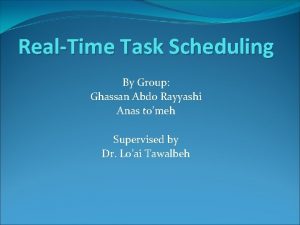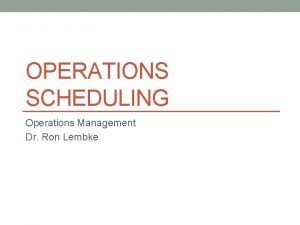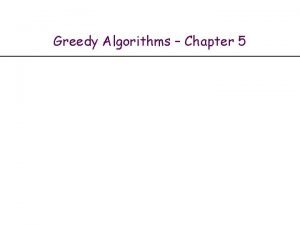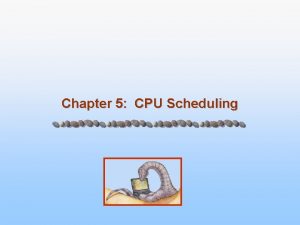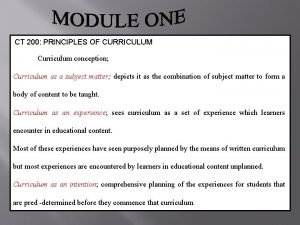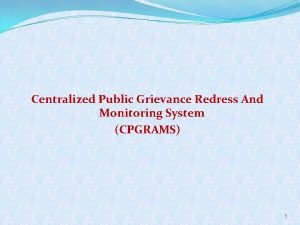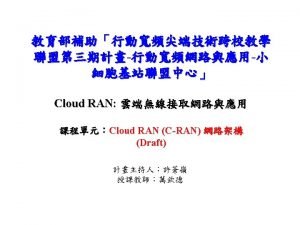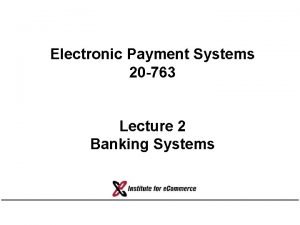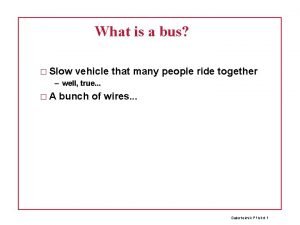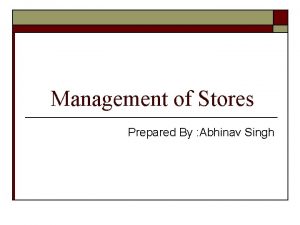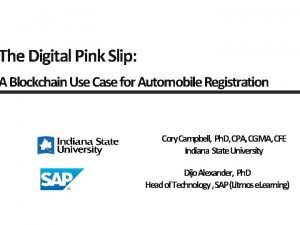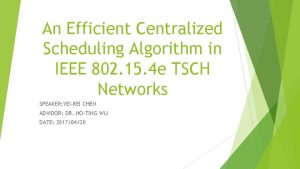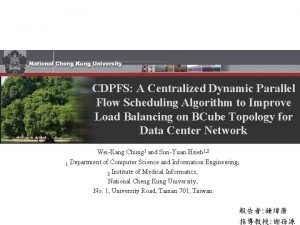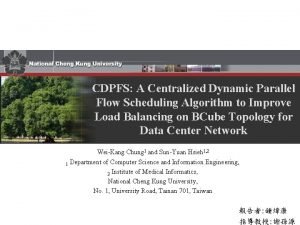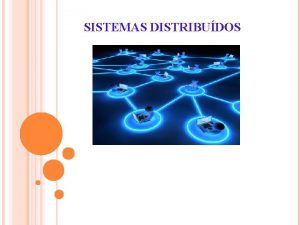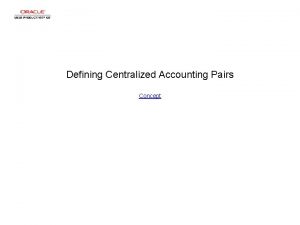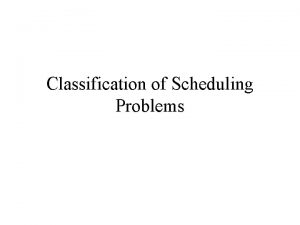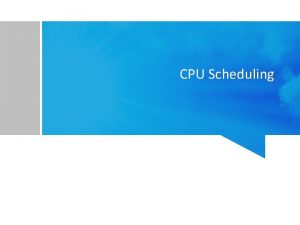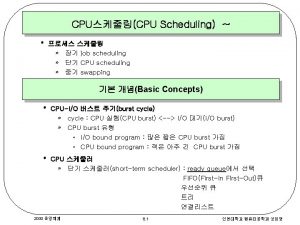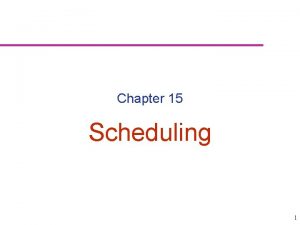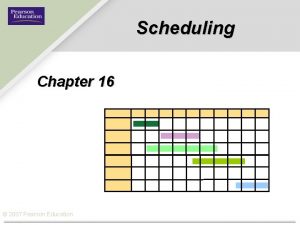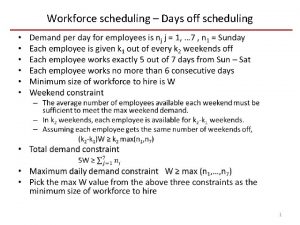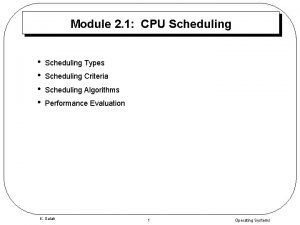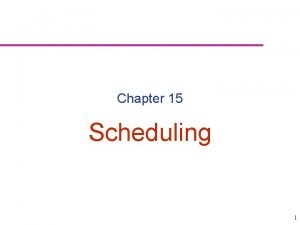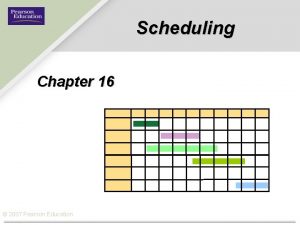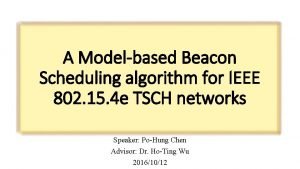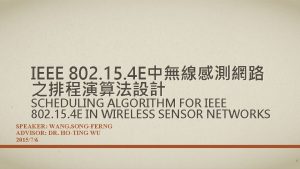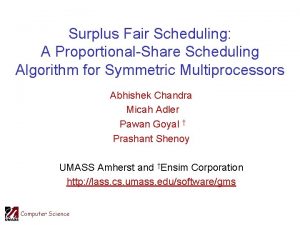A Centralized Scheduling Algorithm for IEEE 802 15






























- Slides: 30

A Centralized Scheduling Algorithm for IEEE 802. 15. 4 e TSCH based Industrial Low Power Wireless Networks SPEAKER: CHUN-TING LIN ADVISOR: DR. HO-TING WU DATE: 2016/11/09

• Introduction • Related Work Outline • TSCH ( Time Slots Channel Hopping ) • TASA ( Traffic Aware Scheduling Algorithm ) • Proposed AMUS Scheduling Algorithm • Energy Efficient Mac Refinement • Simulation Based Evaluations • Conclusion • References 1

Introduction • Factory Automation, Disaster Response Defence, and Safety Applications are highly sensitive to delays and demand high communication reliability. • To overcome these limitations, the Time-Slotted Channel Hopping (TSCH) MAC was proposed. 2

Time Slots Channel Hopping(TSCH ) • Part of the IEEE 802. 15. 4 e standard since 2010, is the latest generation of highly reliable and low-power MAC protocols. • Time slotted access • Predictable and bounded latency • Guaranteed bandwidth • Multi-channel communication • increased network capacity (More node can communication at the same time using different channels) • Channel hopping • mitigates the effects of interference and multipath fading • improves reliability 3

TSCH(Cont. ) 4

TSCH(Cont. ) 5




Distance-2 著色演算法(Cont. ) 9

Adaptive Multi-hop Scheduling (AMUS) AMUS Framework 10

AMUS(Cont. ) • Collect Network Information 1. Each node knows its one-hop neighbor list and its Hop Distance to the sink. 2. The communication interference range is known, which could be estimated during the network initialization stage using RSSI, or use some other models. 3. The average number of packets generated by each node in a single slot frame is known to the PCE. 11

AMUS(Cont. ) • Enabling Multi-hop Scheduling 12

Enabling Multi-hop Scheduling (Cont. ) • Multi-hop Scheduling Sequence (MSS) 13

Enabling Multi-hop Scheduling (Cont. ) • The cell following the scheduling rules : 1. No conflict links scheduled at the same time slot. 2. Interfering links should use different channels if assigned with the same time slot or use different timeslots 3. Non-interfering & non-conflicting links can be scheduled in parallel to use the same timeslot and same channel. 14

Enabling Multi-hop Scheduling (Cont. ) 15

AMUS(Cont. ) • Virtual traffic and Scheduling of Tentative Cells • This unique feature is designed to further reduce latency and improve reliability. • If a packet is dropped due to poor link condition. Those packets therefore need to be transmitted in the next slotframe, resulting in delays. • In AMUS, the scheduler tries to inject more virtual traffic into the network during the scheduling stage and fill as many unscheduled cells as possible in a slotframe. 16

Virtual traffic and Scheduling of Tentative Cells(Cont. ) l Hop distance based proportional fair tentative cell allocation: l Two key parameters which determines the number of tentative cells. 1. The number of existing traffic on links. 2. The number of cells available for a specific link that would not cause interference or collision to other links. 17

Virtual traffic and Scheduling of Tentative Cells(Cont. ) • 18

Virtual traffic and Scheduling of Tentative Cells(Cont. ) 19

Virtual traffic and Scheduling of Tentative Cells(Cont. ) 20

Energy Efficient Mac Refinement • One drawback of this, is that the nodes might have to wake up more often even when there is nothing to send or receive, resulting in an increased duty cycle and higher energy consumption. • The basic idea is that the sender informs the next hop receiver or relay once it sends out the last message in a slotframe and its queue is empty. • When queue is empty , the End-Of-Queue message can be sent immediately. 21

Simulation Based Evaluations parameter nodes area Node’s coverage Slotframe length T mote Sky node TX and RX current consumption Node voltage value 20 35 m 100 slots CC 2420 radio chip (Texas Instruments) 17. 4 m. A / 18. 8 m. A 3 V 22

Resource Utilization 23

Latency and Reliability 24

Radio Duty Cycle and Energy Consumption 25

Node Queue Size 26

Conclusion • 6 Ti. SCH and the IEEE 802. 15. 4 e (TSCH MAC) will be the main enabling technologies for the future wireless industrial applications. • 4 e standard compliant centralized scheduling algorithm AMUS has been proposed to provide optimized schedules and offer industrial grade performance for the low power and multi-hop wireless networks. 27

References 1. Y. Jin, P. Kulkarni, J. Wilcox and M. Sooriyabandara, "A centralized scheduling algorithm for IEEE 802. 15. 4 e TSCH based industrial low power wireless networks, " 2016 IEEE Wireless Communications and Networking Conference, Doha, 2016, pp. 1 -6. 2. IEEE Std 802. 15. 4 e™-2012 3. M. Palattella, N. Accettura, M. Dohler, L. Grieco, and G. Boggia, “Traffic aware scheduling algorithm for reliable low-power multihop ieee 802. 15. 4 e networks, ” in Personal Indoor and Mobile Radio Communications (PIMRC), 2012 IEEE 23 rd International Symposium on, 2012, pp. 327– 332. 28

Thanks for listening ! 29
 Bridges from 802.x to 802.y
Bridges from 802.x to 802.y Bridges from 802.x to 802.y
Bridges from 802.x to 802.y Ieee 802
Ieee 802 Ieee 802 family
Ieee 802 family Ieee 802 3 compliance
Ieee 802 3 compliance Wlan standards
Wlan standards Arquitetura ieee 802
Arquitetura ieee 802 Estandares 802
Estandares 802 Ieee 802 standard
Ieee 802 standard Ieee 802 bluetooth
Ieee 802 bluetooth 802 ieee
802 ieee Job scheduling vs process scheduling
Job scheduling vs process scheduling Least laxity first
Least laxity first Non preemptive scheduling example
Non preemptive scheduling example Windows process scheduling
Windows process scheduling Moore's algorithm scheduling
Moore's algorithm scheduling Greedy interval scheduling
Greedy interval scheduling Elevator scheduling algorithm
Elevator scheduling algorithm A cpu scheduling algorithm determines an order
A cpu scheduling algorithm determines an order Types of curriculum conception
Types of curriculum conception Cpgrams
Cpgrams Centralized leadership
Centralized leadership Channel 9 msdn
Channel 9 msdn Centralized decentralized distributed
Centralized decentralized distributed Emergency drugs in crash cart
Emergency drugs in crash cart Centralized radio access network
Centralized radio access network Citibank money order
Citibank money order Centralized parallel arbitration
Centralized parallel arbitration Advantages of decentralized stores
Advantages of decentralized stores Digital pink slip
Digital pink slip What is north of mesopotamia
What is north of mesopotamia












